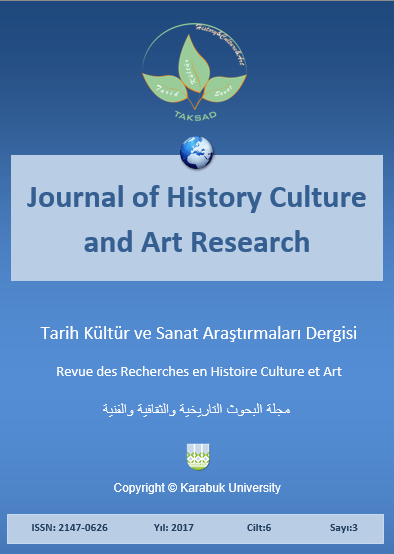An Inquiry into Teaching the Perceptual Effects of the Measures to the Students of Architecture
DOI:
https://doi.org/10.7596/taksad.v6i3.968Anahtar Kelimeler:
Dimension- Perception- Basic education- Architecture- Learning.Özet
This paper investigates the “increasing level of consideration among students about the effects of environment’s perceptible dimensions on human’s mind”. Firstly, to recognize the topic, with a review in architecture and psychology, it seems that perceptible dimensions in environment have great effects on human’s mind. It is noticeable that mentioned effects are studied in combining format with other constructive elements such as shape and etc. To facilitate access, in first part of a classified information covering different effects of dimensions on human’s feeling and perception are provided to use it to form the educating criteria and to enter in educating architecture. Moreover to determine suitable method of education of basic students related to subject of issue, with investigating related theories about educating methods and referring to expert’s ideas about basic education of architecture and consequently considering their ideas it seems that: with providing opportunities in the form of “students’ guided attendance in environment by moving from instances to concepts” it is possible to simplify learning procedure among basic architecture students using various formats of Learned-Centered Instruction training method. The methodology of this research is based on Deductive-Qualitative approach. Analyzing professors’ interviews is performed to recognize the principles, by accurate coding and combing results, and finally codification an educating format for answering this research’s concern.
Referanslar
Alayee, A. (2016). Answer To Research Questions in Interview And Meetings.
Amid, H. (1995). Amid Dictionary, Tehran: Tehran, Fourth Edition.
Arenhime, R. (2009). Architectural Forms, Translated By Qayoomi Bidhendi, M, Tehran, Organization Of Study And Compilation Of Humanities Books.
Arenhime, R. (2014). Art and Visual Perception: Psychology of Creative Eye, Translated By Akhgar, M. Tehran: Organization of Study and Compilation of Humanities Books.
Bokharayee, S. (2014). Architecture and Spatiality: Sequence of Related Spaces to One Episode in Emotional Sense of Spatiality, PHD Thesis of Shahid Beheshti University.
Christopher, A. (2011). The Nature of the Order (Live Structures in Architecture), Translated By Sabri, S. Akbari, A. Tehran: Parham Naqsh.
Dehkhoda, A. (1998). Dehkhoda Dictionary, Under Supervision of Moeen, M, Tehran: Tehran University, Second Edition.
Greuther, Y. C. (2009). Aesthetics in Architecture, Translated By Pakzad, J, Tehran: Shahid Beheshti University.
Hojat, E. (2003). Architecture Education of Worthlessness Values, Fine Arts, No 14.
Hojat, E. (2014). Architecture is in My Heart, Tehran: Yaqmayee.
Hojat, E. (2014). Buildings Talk with Me, Tehran: Yaqmayee.
Hojat, E. (2016). Answer to Research Questions in Interview and Meetings.
Karbasi, A. (2016). Answer to Research Questionsin Interview and Meetings.
Lawson, B. (2005). How Designers Think: Disambiguation of Design Process, Translated By. Nadimi, H. Tehran: Shahid Beheshti University.
Mahmoudi, A. (2016). Answer to Research Question in Interview and Meetings.
Navayee, K. (2016). Answer to Research Questions in Interview and Meetings.
Pakzad, J. & Bozorg, H. (2015). Environment Psychology ABC for Designers, Tehran: Armanshahr.
Sadeghpay, N. (2015). A Look to View, Tehran: Shahid Beheshti University.
Seif, A. (2015). Modern Educational Psychology (Learning Psychology and Education), Tehran: Doran.
Shahcheraghi, A. & Bandarabad, A. (2015). Surrounded in the Environment: Environment Psychology in Architecture and Urbanism, Tehran: SID Tehran.
İndir
Yayınlanmış
Nasıl Atıf Yapılır
Sayı
Bölüm
Lisans
Tarih Kültür ve Sanat Araştırmaları Dergisi'nde yayımlanan tüm çalışmalar Creative Commons 4.0 CC-BY lisansı ile lisanslanmıştır.
Bunları yapmakta özgürsünüz:
- Bu eseri her boyut ve formatta paylaşabilir — kopyalayabilir ve çoğaltabilirsiniz.
- Materyalden Adapte et — karıştır, aktar ve eserin üzerine inşa et
- her türlü amaç için, ticari amaç da dahil
Alttaki şartlar altında:
Atıf — uygun bilgiyi, lisansa linki, and ve değişiklik yapıldıysa değişiklik bilgisinivermelisiniz. Sizi veya kullanımınızı lisansörün onayladığı bilgisini içermemek kaydıyla, size uygun şekilde bu işlemleri gerçekleştirebilirsiniz.
AynıLisanslaPaylaş — Eğer materyali karıştırdınızsa, aktardınızsa ya da materyalin üzerine çalıştınızsa, ancak aynı lisans ile dağıtabilirsiniz.
- Ek sınırlamalar yoktur — Lisansın izin verdiği hakları başkaları üzerinde kanunlarla ya da teknolojiyikullanarak sınırlayamazsınız.







